CHAPTER 1
GROWTH IN PLANTS AND ANIMALS.
KEY TERMS AND CONCEPTS.
- Growth- This is irreversible increase in size and mass of an organism
- Development- refers to changes in complexity of an organism
- Mitosis- this is the process by which cells divides forming two daughter cells
- Allometric growth- a type of growth whereby different parts of an organism grow at different rates and stop growing at different times.
- Diffuse growth- this is type of growth whereby growth occurs all over the body of the organism.
- Localized growth- this is a type of growth whereby growth occurs in certain regions only.
- Intermittent growth- occurs in arthropods whereby growth takes place in series of stages.
- Isometric growth- this is a type of growth whereby all parts of body grow at the same rate.
- Determinate growth- this is a type of growth which stops when a certain age is attained.
- Infancy- this is a period of child growth between 0-5 years.
- Weaning- this is the introduction of solid food substance to a baby.
- Adolescence- this is a period between childhood and adulthood. This period is accompanied by rapid physical and emotional changes.
- Viability- this is the ability of a seed to germinate
- Epigeal germination- this is a type of germination in which the cotyledons emerge to the surface.
- Hypogeal germination- this is a type of germination whereby the seed coat or cotyledon remain underground.
- Seed-dormancy- refers to temporary inhibition of growth of an organism or part of it.
- Primary growth- refers to the increase in length of shoots and roots.
- Secondary growth- this refers to the increase in thickness (girth) of woody stems and roots.
- Apical dominance- this refers to the inhibition of development of lateral buds by the terminal bud.
Growth is permanent and irreversible increase in size. It is brought about by the increase in the number of cells, cell division, cell enlargement and cell differentiation.
- Growth is measured using a growth curve.
- This is a curve obtained when data collected during stages of growth is plotted against time.
- Growth in many organisms tends to be similar whereby there is rapid growth, average growth and finally slow growth.
- This pattern gives an S – shaped curve known as sigmoid curve. When sigmoid curve is closely analyzed, four distinct phases are obtained. These are;
- Lag phase
- Log phase
- Exponential phase
- Linear or decelerating phase
- Stationary phase
Diagram.
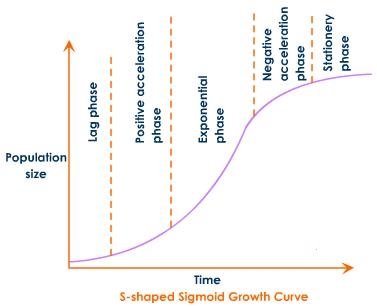
Figure 1.1. Growth Curve
The phases are described below;
- Lag phase.
- Is the phase where the rate of growth is very slow.
- During this period, called the lag phase, the cells are metabolically active and increase only in cell size.
- They are also synthesizing the enzymes and factors needed for cell division and population growth under their new environmental conditions.
- Exponential phase
- This phase involves very rapid or exponential growth. The number of dividing cells is very high than the shed off cells. New tissues are formed.
- Decelerating phase
- This involves the decline in the rate of growth. As maturity approaches, the rate of cell divison decreases. The ability of cells to divide declines as the cells mature.
- Plateau phase
Marks the period where there is no change in the size of the organism. The organism has attained maturity. The cells are formed only to replace those which are worn out.
Measurement of growth.
Growth in living organisms can be measured by several methods, these include the following;
- Length- for example measuring inter nodes in stems
- Width- measuring the diameter of a tree trunk over time.
- Area- measuring the surface area for example the leaves surface area
- Fresh mass- this is measuring the mass of the whole organism
- Dry mass- involve heating an organism to dry weight to dessicate it and then measure the weight over time.
Growth in Arthropods.
- Arthropods shows discontinuous growth, this is a type characterized by number of periods of rapid growth followed by periods of little or no growth.
- This pattern is attained because the arthropods have to shed exoskeleton before they can grow. This is called moulting.
- Exoskeleton is very hard and does not allow growth. Growth occurs only when the exoskeleton is shed.
- Moulting is brought about by hormone which causes old skeleton to weaken and new skeleton to be formed. This hormone is called ecdysone.
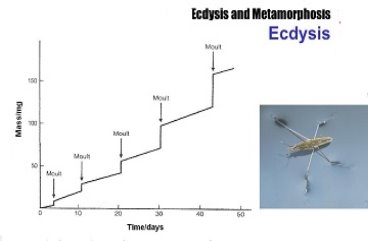
Figure 1.2 Discontinuous Growth in Arthropods.
Mitosis and growth.
The body of an organism is made up by two categories of cells;
- Reproductive cells- which are responsible for the formation of gamete
- Somatic cell- which are also called body cells
The number of cells in a body are sad to be diploid number, which is denoted as 2n. Different organisms have different number of chromosomes,
- Man has 46 chromosomes
- A cat has 38 chromosomes
- Maize has 20 chromosomes
- Tomato has 24 chromosomes
- The growth of organism is brought about by the division of cells.
- Cells divides repeatedly forming new cells which increase the size of an organism. This increase in cells through cell division is called mitosis.
- Mitosis is responsible for growth in living organism.
- During mitosis, cells are formed, each cell has the same number of chromosome as the parent, hence called daughter cell. Thus they are just diploid as the parent.
- Chromosomes are thread like structures found within the nucleus of the cell. The chromosome become visible when a cell is dividing.
- The chromosomes are composed of chromatid threads that are spread out within the nucleus of the cell.
Mitosis occurs in five stages; these are;
- Interphase
- Prophase
- Metaphase
- Anaphase
- Telophase.
Interphase.
This is a stage between two successive divisions. It is thought as a stage of preparation for cell division. During interphase the following happens;
- Chromosomes appear as long thin threads
- Chemical process takes place in order to build energy for division
- Cell organism such as mitochodrion, centrioles, and nucleotides replicate
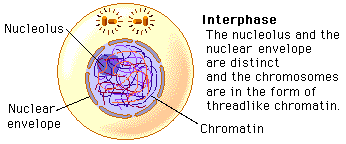
Figure 1.3 Interphase
Prophase
The cell at this stage is mobilized for division.
- Chromosomes gradually become short and thick
- They become visible under light microscope
- Each chromosome forms two sister chromatids which are attached at a point called centromere
- The nucleoli disappear, nuclear membrane breaks down
- Spindle fibres appear though not fully formed.
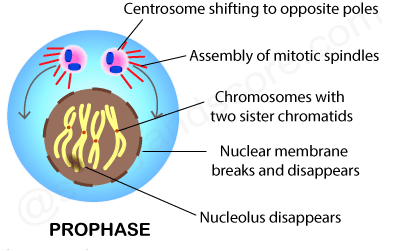
Figure 1.4
The spindle fibres are thread like structures attached to the centrioles and are responsible for the separation of the chromosomes.
Metaphase.
This is marked by the arrangement of the chromosomes at the equator. The spindle fibres are fully formed. The chromatids of each chromosomes are attached to the spindle fibres at the centromere. By the end of the metaphase, the chromosomes are arranged at the equator of the spindle fibres.

Figure 1.5
Anaphase.
During anaphase, the centromere separate. The spindle fibres shorten, pulling apart the sister chromatids towards the opposite poles of the cell. By the end of the anaphase, chromatid arrive at the equator.
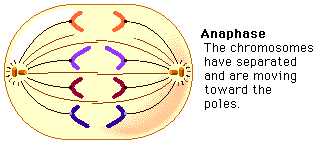
Figure 1.6
Telophase
Is the last stage of the mitosis process where chromatids become chromosomes
- The spindle fibres disappear
- Chromosomes become less visible under the light microscope
- The nucleolus reappears, and new nuclear membrane is formed around a set of new chromosomes.
- In animal cell the cytoplasm constricts and finally divides the parent cell into two daughter cells, in which the two daughter cell have same number of chromosomes as the parent cells.
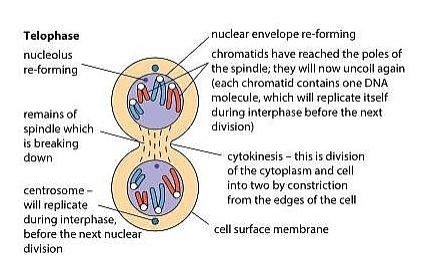
Figure 1.7
- In the plant cell, a cell plate is formed, separating the cytoplasm of the two daughter cells along the equator of the spindle.
- The cell plate is formed from vesicles which collect at the middle of the parent cell. The vesicles are structures that contain materials for making the cell wall, the vesicles join to form cell plate.
- The cell plate grows outward and eventually fuses with the cell wall of the parent cell, dividing it into two daughter cells which contains similar number of chromosomes as those of the parent.
Significance of mitosis
Mitosis is important in various aspects as explained below;
- It is a means of reproduction for organisms producing asexually
- Mitosis results into genetic stability because the daughter cells retains a similar number of chromosomes as the parent
- It is responsible for repair of parts of the body that has been damaged through cell generation
- It is used in generation of body parts which have been cut off. If a tail of a lizard is cut, it can be regenerated to original size.
- It is useful in the replacement of old cells in multicellular organisms
Factors affecting growth in plants and animals.
Growth in plants and animals is affected by a number of factors; these include the following;
Plants
- Hereditary factors
- Hereditary factors affect the physical appearance and size of the plants. These hereditary factors are called genes.
- They found in the chromosomes inside the nucleus of the cell. Genes are inheritable as they are passed from parents to offsprings.
- For example a tall plant will likely produce a tall plant.
- Growth hormones
- These are chemical substances that influence the physiological process. They affect growth in various ways.
- Growth hormones in plants are called auxins and promote growth in plants.
The following are some of the examples of growth hormones
- Indole acetic acid
- Promotes general growth
- Cause abscission in plants- this is the layer at the base of leaves, fruits and flowers responsible for their fall
- Induces parthenocapy
- Promotes apical dominance
- Causes the formation of the callus tissue
- Gibberellins.
This hormone has the following roles
- Promotes cell division and elongation in dwarf plants
- Cause parthenocapy- production of fruits without fertilization
- Promotes growth
- Promote lateral root development
- Inhibit formation of abscission layer
- Break seed dormancy
- Promotes the germination of seeds
- Inhibit development of adventitious roots
- Cytokins
This hormone plays the following roles in plants
- Stimulates cell division
- Stimulates the formation of the callus tissue
- Promotes flowering
- Break seed dormancy
- Promote the development of lateral buds and adventitious roots
- Ethylene.
This hormone is also called ethane. It has the following function;
- Promotes ripening of fruits
- Causes the formation of callus tissue
- Stimulates the thickening of the stem while inhibiting stem elongation.
- Abscisic acid- ABA
Responsible for the following;
- Induces dormancy in seeds
- Cause fruits and leaves fall
- High concentration causes stomata to close
- Promote flowering
- Stimulates apical dominance by suppressing development of lateral buds.
- Apical dominance.
- This is the growth of the apical meristem while inhibiting the growth of lateral meristem. It cause plant shoots to have a conical shape.
- Apical dominance is caused by auxin hormone. It is produced by the apical bud and diffuses at the lower parts of the plant.
- These auxins retard the growth of the lateral buds. Apical dominance can be overcome by cutting the apical bud, this cause the lateral buds to grow.
- This is the biological importance of pruning plants like tea, rose, cypress and bougainvillea.
External factors affecting growth in plants.
- Plant nutrition- plant needs all nutrients in a balanced way in order to have proper growth. Lack of these nutrients can make the plant not to grow well.
- Water- majority of the plant body is made of water. Lack of water can make a plant to start wilting. Plant needs water for photosynthesis and other metabolic processes.
- Light- this is one of the row materials for photosynthesis. Adequate light is very important because plant will make food needed for growth. Blue light is necessary for growth of leaves, whereas a combination of red and blue light promotes flowering of plants.
- Absence of light makes the plants to yellow, stems thin and long and spaces between inter nodes to increase.
- Temperature- optimum temperature is required for photosynthesis. Temperature is important in photosynthesis, metabolism, germination and flowering. This is because temperature affects enzymes which control these processes. Very high temperature will denature enzymes, while very low temperature will slow down metabolism.
- Relative humidity- this is defined as the ratio of water vapor in the air to the amount of water in the air. Humidity affect the rate of transpiration hence water uptake in plants
- Carbon dioxide and oxygen concentration- carbon dioxide is required in the process of photosynthesis. Oxygen is required for plant respiration and utilization of the by-products of the photosynthesis.
- Soil- the type of soil will affect the availability of nutrients in the soil. The soil PH will also affect the growth of plants.
Internal factors affecting growth in plants.
- Genetic make up- genes inherited from the parents affect the growth of the individual. A child likely inherit the characteristic of the parent. Parents with genetic disorders are likely to pass those traits to their parents. For example, a growth disorder called achondroplasia is genetically transmitted and the offspring is abnormally short.
- Hormones- growth hormones have an impact of the rate of growth, these hormone include the following;
- Under-secretion of growth hormone will cause the child to suffer from dwarfism, while its over secretion will lead to gingatism
- Under-secretion of thyroxine will lead to slow down of physical and mental development leading to a condition called cretinism.
External factors affecting growth in animals.
- Temperature- warm temperature increases metabolism while low temperature slows down metabolism. A tadpole will grow faster in a warm pond than in a cold pond.
- Oxygen- availability of oxygen will not affect growth in terrestrial organisms because there is a lot of oxygen in the air. However in aquatic organism it has little effect.
- Nutrition- lack of enough food can cause stunted growth, while a balanced diet will guarantee proper growth.
- Diseases- diseases can affect or interrupt growth. For example, diseases like diarrhea inhibits absorption of nutrients in the body that are necessary for growth.
SUMMARY
- Growth is a permanent and irreversible increase in size. It results from an increase in the number of cells in an organism.
- Growth can be measured using the sigmoid curve is a graph obtained from plotting growth data against time. The curve has four phases which are the lag phase , the log phase or exponential phase, the liner or decelerating phase and the stationary phase.
- Growth occurs as a result of mitosis. Mitosis is the process in which cells devide during growth to form new cells which are similar to the parent cells. It leads to an increase in the number of cells within an organism. Mitosis occurs in the somstic cells during the growth of an organism.
- During the mitosis two daughter cell are formed. Each daughter cell has the same number of chromosome as the parent cell. This is referred to as diploid.
- Mitosis has five phases. These are interphase, prophase,metaphase, anaphase and telophase.
- In the animal cell the cytoplasm constricts and finally divides the parent cell into two daughter cells has the same number of chromosomes as parent cell.
- In a plant cell, a cell plate is formed separating the cytoplasm of the two daughter cells along the equator of the spindle. The cell plate is formed from vesicles which collect at the midline of the parent cell.
- Mitosis is very important because of the following reasons:
- It results into genetic stability
- It is a means of reproduction for organisms reproducing asexually.
- It leads to repair and regeneration of damaged body parts and replacement of old cells in multicellular organisms.
- Growth in both plants and animals is affected by number of factors. Some of these factors are internal such as heredity and some of these factors. Some of these factors are internal such as heredity and hormones while others are external, for example light, temperature, oxygen, inorganic materials in the soil, nutrition and diseases.
GROWTH AND DEVELOPMENT IN HUMAN BEINGS.
Terms associated with growth in animals.
- Prenatal development- this is growth that takes place in the womb before the baby is born
- Post-natal development- this is growth and development that occurs after the baby is born
- Limited growth- this is the type of growth that ceases at maturity, the growth curve flattens or even declines prior to death.
- Unlimited growth- this a type of growth where an organism grows throughout the its life. It occurs in some mammals and plants.
- Allometric growth- is a type of growth in which organs grow at different rates
- Growth spurts- these are periods of rapid growth in the life of an organism. In humans, there are two such periods, at infancy and during adolescence.
Stages of growth in human beings.
Growth in human beings occurs in various stages as follows;
- Childhood
- Adolescence
- Adulthood
- Aging( senescence)
Childhood stage’
This is the period from which the baby is born to sexual maturity, about 11 years. Childhood has several stages;
- Neonatal- is the stage from birth to 4 weeks. New babies are called neonates
Physical and physiological changes during this stage;
- The baby is helpless and communicates through reflexes
- They suck everything they come across
- They see at a very short distance
- The head and abdomen are bigger than the rest of the body
- The immunity is immature and the child depend on immunity from the mother
- The baby can sit with support and can respond to sounds
Babies at this stage express their feelings through crying. They cry to show anger, hunger, fear, tiredness and other discomfort.
- Older baby.
This is from six to 12 months.
Physical and physiological changes during this stage
- The baby can control head and sit without support
- At 7 months, the baby learns to crawl
- Can stand while holding objects
- Teething occurs at this period
- From 9-12 months the baby can start to walk
- The baby can see far objects
Behavioural and psychological changes.
- The baby can respond to her own name and other familiar sounds
- The baby can distinguish strangers from familiar people
- At year 1 can understand and obey simple commands
Toddler.
This is the age between 1-3 years
- The brain is 90% developed
- Heart beat is reduced to 9-110 times per minute
- The child can control urination and defaecation
- Immune system become mature
- The baby can see anything that the adult can see
- The baby shows sense of colour
- All milk teeth appear by age of 3 years
- Hearing has developed well
Behavioural and psychological changes.
- 12-14 months, uses gestures to express her feelings
- 15 months- the child copies what the adult can do
- 15-18 months- the baby feeds themselves, address adults, climb furniture such as bed
- 19-24 months- play with other children, show anger-tundrums, vocabulary is well advanced, he has began learning toileting.
- 25-36- the child can speak sentences, differentiate boys and girls, have preference for clothes and toys, feel jealousy towards new born. They also fear particular things like insects.
Early childhood
This is from 4-6 years.
Behavioural and psychological changes.
- The child has good appetite thus grows very faster
- Can identify up to five colours
- Motor coordination is well developed
Psychologicl changes
- The child is very curious and imaginative
- He or she understands right and wrong
- He or she is curious about sexulity
- The child can speak fluent, can tell his or her age and can speak fluent
Late childhood
This age ranges from 7-9 years
Physical and physiological changes during this stage
- Growth remains steady
- Children are very active
Psychological changes
- The child can assume simple responsibilities like looking, after the house when the parents are not their
- The child is very social and likes to socialize and belong in groups
- Can help with house hold chores
- Likes to associate with peers with similar interests
- Children have friends and best friends but prefer friends of the same sex.
- At this stage, they listen to the peers opinion but still value the opinion of the parents
Pre-adolescence.
This is the age from 10-11 years.
Physical and physiological changes.
- Growth starts to increase
- Appetite increases
- Secondary sexual characteristics starts to show eg breast growth and growth of hair in pubic and armpit areas
Psychological changes
- Children still prefer friends of the same sex
- They start to become independent from the family
- Children are very social and tend to value peers opinion
Services required to meet the needs of the children
The following services are necessary and important in the growth of the children.
- Health food including balanced diet
- Protection from illness and injury
- Exercise and rest
- Warmth
- shelter
Adolescence
This is a stage of human development from childhood to adulthood. It ranges from age 12-18. Girls reach adolescence earlier than boys. During this stage, and individual experiences a lot of changes both physical and psychological.
Physical changes in an adolescent.
- Rapid growth in weight and height
- They become energetic and active
- Hair grows in armpits and groins of both boys and girls. Boys grow beards and hair in the chest
- Girls start to undergo menstruation
- Girls grow breasts
- Boys sex organs enlarge
- Boys deepen their voices
- Pimples appear on the face
Psychological and behavioural changes at puberty.
- The adolescence have strong attachment to peers than parents, guardians or teachers
- The child has positive development like social skills like empathy, sharing, leadership, and academic motivation.
- Experimentation to drugs and sex
- Sexuality and sexual desire.
Because of these changes, adolescents are required to maintain high level of cleanliness
Services required to meet the needs of adolescents
- Healthy food for growing body
- Peaceful home, security, emotional support and counselling
- Social skills to help them resist temptations
Adulthood
Starts from 20-55 years. Divided into earlier adulthood, middle adulthood and old age.
Earlier adulthood.
Ranges from 20-25 years
- Growth has stopped only maintenance of body parts
- People are at their best physical condition, very strong, energetic, good memory, sharp senses and stamina.
- Performance of body parts is very high
- People are very ambitious and want toe succeed
- They are selective in terms of choosing occupations or partners
- They have the desire to be socially independent.
Middle adulthood
Starts from 26-55 years
The person is still very strong and can do tasks well.
- Performance of body system is still high
- In late forties, deteriotion of the body is high
- Memory loss occur, vision decrease
- Hair starts to grey
- Skin start to lose elasticity
- Women reach menopause and their desire to have sex is reduced.
Old age.
Starts from 56 and above
Changes that takes place
- Decreased blood flow to the brain and death of nerve cell
- Ability to focus on objects, smells, and hear decreases
- Hair turns grey
- Kidney function slows down and frequency of urination increases
- Digestion slows down especially those who gets poor diet
- Elasticity of the skin decrease
- Bones become weak
- Men delay getting an erection
- Taste buds die, making one to feel the food is tasteless
Services rendered to needs of the elderly.
- Food to strengthen their immunity
- Avoid poor eating habits
- Avoid drugs and alcoholism
- Make body exercises
The following factors affect the rate of physical deterioration of the human body.
- Smoking
- Alcoholism
- Drug use and abuse
- Stress
- Inactivity
- Poor diet
- Diseases and infections
- Poor diet
- Chemicals and radiations
- Werner’s syndrome
SUMMARY
- Development is an increase in the complexity of an organism. Development accompanies growth.
- Growth and development in humans can be prenatal or postal natal. Prenatal growth and development is the one which takes place in the womb before the baby is born.
- Human beings and other mammals show limited growth. Limited growth is growth that ceases at maturity.
- Human have two periods of rapid growth called growth spurts. One growth spurt occurs in early infancy and the other during adolescence.
- The human post natal growth and development comprises five main stages namely childhood, adolescence, adulthood, and aging (senescence).
- Childhood is the period from when the baby is born up to sexual maturity ( about 11 years). Childhood has several stages namely neonatal, older baby, toddler, pre- school, early childhood, late childhood and pre-adolescence.
- For children to growth and develop well, they need food, shelter warmth, comfort, security, training of good habits and skills, rest and enough sleep.
- Older people need health soft food to strengthen their immune system, comfortable clothing and a place to sleep , and do light physical exercise. They also need love, care and support.
- The rate of determination of the human body is affected by a number of factors. Some of these factors are psychological and include smoking alcoholism, drug abuse, stress and inactivity.
Some other factors are environmental and include poor diet, excessive noise, toxic chemicals and radiations, diseases and infections.
GROWTH AND DEVELOPMENT IN FLOWERING PLANTS.
- Growth and development occur throughout the life of a plant. Development is brought about by increase in complexity of the organism.
- In earlier stages of life, plants grow very faster, then growth slows down as they age.
- In plants, growth and development begins with germination of a seed. Germination is the process by which seeds undergo initial stages of growth, developing into a seedling. It is the change of a seed into a seedling given the right conditions.
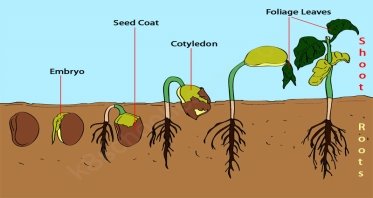
Figure 1.8
Parts of a seed.
A typical seed is made up of the following parts,
- Embryo- the embryo grows and develops into a mature plant which produces more seeds. It is made up of plumule, radical and cotyledons.
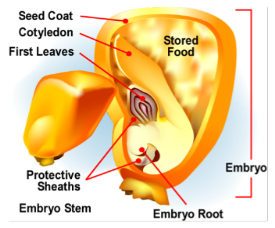
Figure 1.9
- Plumule- is the part of embryo that develops into a shoot
- Radicle- is the part that develops into a root
- Cotyledons- have nutrients which are utilized by the seed during germination.
There are two types of seeds depending on the number of cotyledons. These are as follows,
Monocotyledon- are seeds which are made up of one cotyledon example include, maize, rice, wheat
Dicotyledon- are seeds with two cotyledons- examples includes bean seeds, and groungnuts
- Endosperm – this additional nutrient tissue found in some seeds.
- Seed coat- it is also called the testa, it encloses fertilized ovule, it has a hole called micropyle which allows the entry of air and water
- Hilum – a scar found on the seed, the hilum marks the point of attachment to the funicle.
- Funicle- attaches the seed to the placenta of the ovary wall
Conditions necessary for germination.
There are three important conditions for the process of germination; these are- water, warm and air.
Water
It is required for enzymes activities. It enters the seed through the micropyle. It soften the testa allowing water to enter in. it enters into the seed by the process of osmosis.
The role of water in germination;
- Provide medium for functioning of enzymes
- Hydrolysis of stored food substances for respirations
- For dissolving food substances for easy transport
- Development of cell sap vacuoles.
Oxygen.
- It diffuses into the seed through the micropyle. When testa is raptured, oxygen diffuse directly into the tissues.
- Oxygen is used during respiration for production of energy for processes like cell division and transport.
Optimum temperature.
- Enzymes which assist in germination needs the right temperature to function. High temperature denatures enzymes, while very low temperature deactivates them.
Light.
This varies from one plant to another. Some plants needs light to germinate while other do not need light.
Types of germinations.
- Basically we have two types of germination; hypogeal germination and epigeal germination.
- Hypogeal germination- in this type of germination, the seed cotyledon remains underground. Maize and pigeon peas shows this types of germination.
- The part of the embryo that elongates is the epicotyl. The epicotyl elongates rapidly raising the plumule above the soil. The cotyledon remains below the soil.
- In maize plant, the plumule sheath called the coleoptile protects the plumule. The coleoptile grows towards light.
- Foliage leaves emerge from the coleoptile and help in carrying out photosynthesis. The radicle is protected as it emerges from the maize seed by a sheath called coleorhiza.
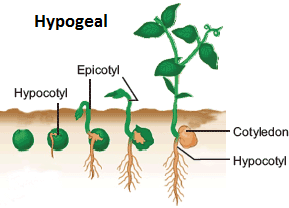
Figure 1.10
- Epigeal germination- is a type of germination in which cotyledons are brought on the surface of the soil.
- This type of germination occur in plants such as beans and peas. Some monocotyledonous plants such as onions also show epigeal germination.
- The plumule and radicle are attached to the two cotyledons. The hypocotyl elongates rapidly raising the cotyledons in the air.
- The hypocotyl is the region of the stem beneath the cotyledon and directly above the roots of a seedling.
- The epicotyl is the region of the shoot of a seedling which is found above the cotyledon of an embryo.

Figure 1.11. Epigeal Germination.
The process of germination
- The seed absorbs water and softens the testa
- The cotyledon swell and rapture the testa
- The radicle elongates and emerges through the seed coat, thus roots develop from the radicle.
- The hypocotyl elongates and develop a curvature. The curved part emerges above the soil. The hypocotyl eventually straightens raising the cotyledons above the soil surface. The cotyledons are also called the seed leave.
- The cotyledon shriven as the stored food is exhausted. The first foliage leaves enlarge and start carrying out photosynthesis. The shriveled cotyledon falls off.
Changes which occur during seed germination.
- The seeds absorbs water from the surrounding region through a process called imbibition. This triggers germination.
- Water softens the testa, cells become turgid as they take in water, the turgidity raptures the testa.
- Water dissolves the food substances so that they can be transported to the growing parts of the plant. Starch is hydrolyzed forming glucose which is used in respiration.
- The energy released during respiration is needed for growth, glucose is needed for making of cell walls.
- Protein stored in the seed are broken down into amino acids. Amino acids are important component in the synthesis of cell membranes and cytoplasm.
- The radicle forces its way out of the testa and plumule elongates and emerges above the ground. The delicate leaves are protected by the cotyledons.
- In hypogeal germination, the cotyledons remains in the ground and supply nutrients to the young seedling until it is able to photosynthesize. In epigeal germination, the cotyledon turn green and photosynthesize.
Seed viability.
A viable seed is one which retains its ability to germinate
Factors affecting seed viability.
Viability is the ability of the seed to stay alive so as to germinate and grow into an adult plant. The following are some of the factors that affect seed viability.
- Seed marturity.
A mature seed is more viable than immature seed
- Temperature and moisture
- Too dry conditions do not allow germination to take place. In the same way, too high temperature, or too low temperature does not allow the germination of seed.
- Storage conditions.
- Storing seeds in areas where it is too hot or too cold kills the embryo. Seeds need an optimum temperature of 25Oc.
- Food stores
- For germination to take place, the seed will need to have adequate food stored. This is marked by large endosperm and cotyledon.
- Testa.
- When the testa is too thin, the seed dries faster and it dies, but when the testa is too thick, it prevents the entry of water and thus inhibiting germination.
Seed dormancy
- Seed dormancy is the inability of the seed to germinate. It is a state of relative inactivity where growth and development stops.
Causes of seed dormancy.
- Temperature.
- Very low temperature prevents germination because it interferes with enzyme activities, a very high temperature will also not allow germination because the enzymes will be denatured. For seed to germinate provide the right temperature
- Thick testa
- The testa prevents the seed from dehydration because it is water proof. A very thick testa however will prevent germination because it won’t allow water to enter the seed.
- Reducing thickness can help to remove dormancy. This can be done by filing, chipping, scrubbing and abrading the testa.
- Immature embryo
If the embryo is immature, germination cannot take place. To break this dormancy, allow the embryo to mature.
- Growth inhibitors
- Presence of chemical substances prevents the germination of seeds soon after dispersal.
- These substances are called growth inhibitors and a good example is abscisic acid. The inhibitors can be overcome by soaking the seeds in water or cleaning them.
- Water dilutes the concentration of the chemicals in the seed and activates growth promoters such as the gibberellin.
- Light.
- Some seeds such as lettuce, capsicum and tobacco need light to germinate. Seeds which don’t require light to germinate are planted deeper into the soil.
- The duration of light is called photoperiodism and affect the germination of seeds. Exposing the seeds to appropriate light will cause germination.
Importance of seed dormancy
- Help an organism to withstand unfavourable climate such as drought which could kill the plant if it were to germinate
- It enables an organism to survive for very long period of time or even years without exhausting its food reserves.
- It allows time for dispersal of seeds by agents such as water and wind.
Growth regions in a seedling.
- The growth of a seedling can be measured from the root tip. The growth of radicle and plumule causes the elongation of the seedling. A radicle develops and forms the root, while plumule develops and forms the shoot.
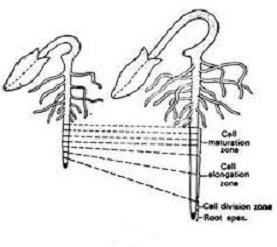
Figure 1.12- growth regions
- The cells with ability to divide are called meristematic cells. The cells make up a tissue called the apical meristem.
- These cells undergo mitosis rapidly enlarging and giving rise to more cells. The cells later differentiate to form tissues that carry out specific functions.
The plant organs elongate, resulting in growth at the root and shoot apices. This type of growth is called primary growth.

Figure 1.13. Growth regions.
- The meristematic tissue at the shoot apex actively divides, leading to the elongation of the shoot. The meristematic tissue also gives rise to leaves.
- Leaf primordia from which the leaves develop occur at the nodes of the shoots.
- The part of the stem between one node and another is called internode. The axillary bud has meristematic tissue known as the intercalary meristem.
- This meristem tissue brings about internode elongation.
Measurement of growth in seedling.
- The growth in a seedling can be measured in terms of; length, width, weight, volume, dry mass fresh mass, and area.
- The measurement of growth in a ben seedling can be carried out by marking the radicle at one mm interval using water proof ink.
- The seedling is then provided with the conditions of growth. It is pinned in a cork and kept in a vertical position.
- The radicle is observe after three days. It is found that the marks are far apart at the region of cell elongation towards the root.
- The part of the radicle just after the apex has meristematic cells that are actively dividing. The zone of cell elongation is behind the meristematic zone. The ink marks are furthest apart in the region of cell elongation.
- The part of the radicle behind the zone of elongation is the zone of the cell differentiation.
- The cells increase in complexity without much growth. Further behind the zone of differentiation is the zone of the cell maturation. There is very little increase in length in the zone of cell differentiation.
SUMMARY
- Growth is permanent increase in the size of an organism. Development is the increase in the complexity of an organism.
- A seed requires water, oxygen and the right temperature for germination to occur.
- A seed has plumule that grows into a shoot system and a radical that grows into a root system.
- Germination is inhibited by conditions such as a thick testa an immature embryo, inadequate temperature, lack of oxygen, moister and light and presence of growth inhibitors such as abscisic acid.
- There are two types of germination hypogeal and epigeal. In hypogeal germination, the cotyledons are left below the soil when the seed germinates. In epigeal germination the cotyledons are raised above the ground when the seed germinates.
- Hormones influence process like cell division, cell enlargement, flowering, fruits formation and root development. Plants hormones include auxins and gibberellins.
- Apical dominance is witnessed when a plant grows tall due to greater elongation of the apical bud in comparison to the lateral braches. Pruning removes the apical bud in comparing removes the apical dominance.
- After germination and earliest stages of development, plants growth becomes localized in specific regions called meristems.
- Meristems are regions in which plant cells divide. Meristems are of two types: apical meristems and lateral meristems.
- Apical meristem is growth region just behind the tips of root (plumule) and shoot (radical). Apical meristem is responsible for plant elongation (increase in length of shoot and roots).
- Lateral meristem is concerned with widening of the plants. Widening of the plant to form the trunk and hard wood is called secondary growth. Examples of plants which show secondary growth are mango trees, baobab tree, jacaranda, eucalyptus and so on.
END OF TOPIC QUESTIONS.
- Growth in plant apical, this means:
- It occurs the middle of the root b) It occurs at the middle of the stem
c) It occurs at all regions d) It occurs from the tips
- The emerging shoot as the seed start to germinate is known as
- A new stem b) Stem c) Plumule d) Radicle
- The hypogeal germination the cotyledons:-
a)appear above the soil b) remains in the ground
c) are brought above the soil d) are slowly brought above the ground
- Seedless fruits like bananas are known biologically as
- Succulent fruits
- Compound fruits
- Single fruits
- Parthenocarpic fruits
- Drupe
- The conjugation sexual reproductive process in paramecium produces
- Only two paramecia
- Only ten paramecia
- Six paramecia
- Eight paramecia
- Four paramecia
- Maize grain is a fruit and not a seed as the structure contain
- One and two scars of attachment
- One scar of attachment
- Two scars of attachment
- Three scars of attachment
- Four scars of attachment
- When it is said that seeds are viable it means:-
- Have lost their ability to germinate
- They are dead
- Cannot germinate
- Do not have life
- Have life
- Dormancy in a seed it means:-
- It has lose its life
- It is completely dead
- It is dry and half dead
- It can geminate
- It cannot geminate
- In hypogeal germination cotyledons are:-
- Bought above the soil surface
- Pushed by hypocotyls over the soil surface
- Left in the soil while the plumule come up – outside the soil
- Shriveled and come above the soil
- Shriveled as they lose food while they are brought above the soil surface
- The characteristics – trait of an organism and some of their behavior are determined chemically by structures known as:-
- Ribosomes
- Genes
- Nucleolus
- F1
- RNA
- At optimum temperature seed can geminate – as at that specific temperature:-
- Enzymes are working better to allow for germination than any other temperature below it or above it
- The endosperm cannot be digested by viable enzymes
- The cotyledons are not having enough food
- Enzymes are denatured
- The cotyledons are having enough food.
- Log phase in terms of growth it means:-
- Growth is go down a bit
- Growth has stopped
- Constant growth
- Rapid growth
- Lag phase in terms of growth it means:-
- Growth is go down a bit
- Growth has stopped
- Constant growth
- Slow growth
- Rapid growth
- When it is said that seeds are viable it means:-
- Have lost ability to germinate
- They are dead
- Cannot germinate
- Do not have life
- Have life
- Dormancy in a seed it means
- It has lost its life
- It is completely dead
- It is dry and half dead
- It can germinate
- It cannot geminate
- In hypogeal germination cotyledons are:-
- Brought above the soil surface
- Pushed by hypocotyls over the soil
- Left in the soil while the plumule come up- outside the soil
- Shriveled and come above the soil
- Shriveled as they lose food while they are brought above the soil surface
- At optimum temperature seed can germinate – as at that specific temperature:-
- The endosperm cannot be digested by viable enzymes
- The cotyledons are not having enough food
- Enzymes are working better to allow for germination than any other temperature below it or above it.
- Enzymes are denatured
- Enzymes are destroyed.
PART II
- a) Differentiate growth in plants from animals.
b) Present growth in plant trees using graphical method.
- Outline the two technical terminologies: (i) Mitosis (ii) Meiosis. Work out the differences of the two terminologies above in Q5.
- How does meiosis enable the introduction of a new organism with different traits in a specific population of plant or animals?
- Write down an Essay on how Diet, behavioral and physiological factors affect growth phases in Human being using the following guidelines:
- Childhood
- Adolescence
- Reproductive age
- Old age
- I. State how the following internal factors affect germination and give examples
(a). Enzymes
(b) Hormones
(c) Viability
II. Describe the factors required by a seed to germinate (two)
(b) Draw well labeled diagrams depicting showing hypogeal germination in a named plant
© What differences are there between hypogeal and epigeal germinations? (two)
- (a) Describe the two technical terminologies
- Pre- natal growth
- Post – natal growth
(b) Draw a graph showing human growth up to 70yrs. Label your graph well
(c) From Q 6 (b) above describe the following stages:-
- Lag phase
- Log phase
- Linear phase
- Stationary phase
(d) Supply the scientific name of the graph drawn in Q6 (b)
7. (a). Give the differences between the following items as used in growth by giving examples.
(i). Diffuse growth and allometric growth
(ii). Limited growth and unlimited growth
(b) (i). Draw the diagram of sigmoid growth curve, label the four significant phases
(ii). Briefly explain why during adolescence stage the rate of growth is rapid.
- (a) Draw a well labeled diagram of apical meristem in the shoot
(b) Locate the region of much cell division
(c ) Explain the terminology “apical meristem” as used in he diagram in Q3(a) above.
(d) Why is it said that growth in plant is epical?
- (a) Define growth in Animals
(b) Mention factors that affect growth in Animals
(c ) Explain the factors mentioned in Q4(b) above
- (a) Mention six external factors that affect growth in plants
(b) How does two factors mentioned in Q5 (a) above affect growth in plants.
- (a) What are the four stages of Human postnatal growth
(b) Describe six services required to meet the needs of children to grow healthy.
- Write down and essay entitled “Post natal Growth” using the following guidelines.
- Childhood
- Adolescence
- Adulthood
- Ageing
- a) Define growth as applied to biology
b) List down four factors influencing growth and explain the role of mitosis in growth of a living organism.
SECONDARY EXAMINATIONS SERIES
TOPICAL EXAMINATIONS
BIOLOGY FORM FOUR- GROWTH AND DEVELOPMENT.
SECTION A 20 MARKS
- MULTIPLE CHOICE QUESTIONS.
- When it is said that seeds are viable it means:-
- Have lost ability to germinate
- They are dead
- Cannot germinate
- Do not have life
- Have life
- Dormancy in a seed it means
- It has lost its life
- It is completely dead
- It is dry and half dead
- It can germinate
- It cannot geminate
- In hypogeal germination cotyledons are:-
- Brought above the soil surface
- Pushed by hypocotyls over the soil
- Left in the soil while the plumule come up- outside the soil
- Shriveled and come above the soil
- Shriveled as they lose food while they are brought above the soil surface
- Under complete Dominancy a gene can:-
- Express itself in homozygous condition
- Express itself in both heterozygous and homozygous condition
- Not express itself in heterozygous condition
- Not express itself in homozygous condition
- Express completely and only under heterozygous condition
- At optimum temperature seed can germinate – as at that specific temperature:-
- The endosperm cannot be digested by viable enzymes
- The cotyledons are not having enough food
- Enzymes are working better to allow for germination than any other temperature below it or above it.
- Enzymes are denatured
- Enzymes are destroyed.
- Growth in plant apical, this means:
- It occurs the middle of the root b) It occurs at the middle of the stem
c) It occurs at all regions d) It occurs from the tips
- The emerging shoot as the seed start to germinate is known as
- A new stem b) Stem c) Plumule d) Radicle
- The hypogeal germination the cotyledons:-
- appear above the soil b) remains in the ground
c) are brought above the soil d) are slowly brought above the ground
(ix) It is a structure found in animal cells and it form spindle fibres that aids separation of chromosomes.
- Centrioles
- Chromatins
- Spindle bodies
- Ribosome
- Log phase in terms of growth it means:-
- Growth is go down a bit
- Growth has stopped
- Constant growth
- Rapid growth
2. Question two is matching type question, select the best response from column b and write its letter besides the question item in the box below.
| i | ii | iii | Iv | v | vi | vii | viii | ix | x |
| COLUMN A | COLUMN B |
|
|
SECTION C. STRUCTURED QUESTIONS.
3. (a). Give the differences between the following items as used in growth by giving examples.
(i). Diffuse growth and allometric growth
(ii). Limited growth and unlimited growth
(b) (i). Draw the diagram of sigmoid growth curve, label the four significant phases
(ii). Briefly explain why during adolescence stage the rate of growth is rapid.
- (a) Draw a well labeled diagram of apical meristem in the shoot
(b) Locate the region of much cell division
(c ) Explain the terminology “apical meristem” as used in he diagram in Q3(a) above.
(d) Why is it said that growth in plant is epical?
- (a) Define growth in Animals
(b) Mention factors that affect growth in Animals
(c ) Explain the factors mentioned in Q4(b) above
- (a) Mention six external factors that affect growth in plants
(b) How does two factors mentioned in Q5 (a) above affect growth in plants.
- (a) What are the four stages of Human postnatal growth
(b) Describe six services required to meet the needs of children to grow healthy.
- a) Differentiate growth in plants from animals.
b) Present growth in plant trees using graphical method.
- Outline the two technical terminologies: (i) Mitosis (ii) Meiosis. Work out the differences of the two terminologies above in Q5.
- Explain what would happen to arthropods like grasshoppers if there is hypo secretion of molting hormones.
- Explain the relationship between mitosis and growth.
- Explain how the following affect growth in plants
- Light
- Nutrients
- Temperature
- (a) Mention the terminology used to describe the growth curve in man
(b) Draw well labeled graph that is mentioned in Q.8 (a) above
- Describe in length the four phases of growth in the curve drawn in Q8 (b) above.
QUESTIONS AND ANSWERS
Q. a) Define growth.
- What is a growth curve
- What is the nature of a growth curve?
- The diagram below shows a growth curve

ii) Mention Parameters which can be used to measure growth
What is discontinuous growth? Why do arthropods experience this form of growth?
- Growth is permanent and irreversible increase in size and mass of an organism.
- A growth curve is a graph obtained when data collected during stages of growth isplotted against time
- A growth curve is sigmoid — forming an S share.
- A — lag phase — has little growth, cells are begging to divide.
C — Linear or decelerating phase — growth decrease as maturity nears.
D- Plateau phase — also called stationary phase. There is no growth experienced — the rate of new cell formation is equal to rate of death.
E — Decline phase — Rate of growth declines. There no new cells being made, and present ones are aging.
iii) Length, width, area, fresh mass Dry mass
e) Discontinous growth is characterized by a number of periods of rapid growth followed by periods of little or no growth.
- Anthropoid experience this growth because of moulting.
Q a) Mention the type of cells found in human body
Differentiate between meiosis and mitosis
Mention the main phases of mitosis
Give and account of what happens during each of the following stages.
i) Interphase ii) prophase iii) metaphase iv) anaphase v) Telophase
Name cell orgamelle responsible for cell division in plants. Differentiate between centromeres and chiasmata
g) What is crossing over? Give importance of this process
h) Give importance of meiosis?
a) Somatic cells — body cells and reproductive cells
Meiosis occur in reproductive cells and results in formation of haploid number of chromosomes while mitosis occur in body cells and produce similar cells with diploid number. It results into growth.
Interphase, prophase, metaphase, Telophase
Interphase — is stage between one cell division and another.
Chromosomes appear like threads
Build up of energy takes place
Cell organelles replicate
Prophase
Chromosome shorten and become visible
Sister Chromosomes are attached to contromere
Nucleolus disappear, and nuclear membrane breaks down.
spindle fibres appear
Metaphase
Chromatids are arranged at the equator.
Spindle fibres are joined at the chromosomes .
Anaphase
Centromere separate
Spindle fibres shorten, pulling a part sister Chromosomes
Chromatids arrive at the poles.
Telophase
Chromatids becomes chromosomes
Spindle fibres disappear
Nucleolus reappears, nuclear, membrane form around each set of chromosome
Cytoplasm constricts and finally divides
e) Centriole
Centromere is a point of contact where chromosome is Joined. Chiasmata — This is a contact between two chromosomes during crossing over.
Crossing over is when chromatids overlap over each other and share genetic materials.
Significance of mitosis
Maintains genetic stability. Daughter cells are identical.
Means of reproduction for asexual reproduction.
It repairs body parts which are injured.
It leads to generation of new parts of organism
Old cells are replaced through mitosis
Q a) Mention factors affecting growth in plants and animals.
b) Give the function of the following hormones
i) Auxin ii) Gibberellins iii) Cytokinis iv) Ethylene
A a) Factors affecting growth in plants
i) Internal factors
Hereditary factors
Growth hormone
Apical dominance
ii) External factors affecting growth in plant
Plant nutrition
Water
Light
Temperature
Relative humidify
Internal factors affecting growth in animals
Genetics
Hormonal
iii) External factors affecting growth in animals.
- Temperature
- Oxygen
- Nutrition
- Disease.
Q a) What do you understand by
i) Limited growth ii) senescence iii) unlimited growth iv) allometric growth.
What is growth spurt? When is growth spurt experienced in humans?
State physical, physiological and Behavoural change associated with the following stages
- Childhood ii) adolescent iii) Adulthood.
Childhood
- Neonatal Depend on reflexes Suck things by mouth Can see at small range
- Immature immune system Heart beat rate is high Communicate by crying
Late childhood
- Growth is steady
- Children are very active
- Performs sample activities like cooking Prefers friends of same sex
- Child is very social
Adolescent
- Rapid growth of body
- Very energetic
- Secondary sexual characteristics appear
- Positive personality development
- Conflict of interest arise
- Sexuality and sexual desire
Adult hood
- One is very strong in doing activity
- Growth has stopped
- Hair starts to turn Grey, skin loose elasticity
- Women reach menopause and their desire to have sex is reduced.
Factors affecting rate of detoriation in human body.
1. Smoking
- Cause premature balding winkling and osteoporosis - Can case lung cancer
2. Alcoholism
- Damage central nervous system
- Risks of heart stoke, breast cancer
- Kidney failure/ osteoporosis
3. Drug abuse
Premature aging caused by destruction of nervous system
4. Stress
- Heart problems, high blood pressure
- Impairment of nervous system
- Fatigue, insomnia, ulcers, headache
5. Inactivity
- Over weight and associated risks which can cause other illines
- Poor diet
- Over feeding cause obesity and diabetes
Disease and infection
- Chemical and radiation
- Werner's syndrome:- Caused by gene mutation and cause rapid aging.
Q a) What is germination
- Part of a seed that forms root is……….. while part that forms shoot is…………………
- Explain the role of the following in germination i) Water ii) Oxygen iii) Temperature.
- Differentiate between epigeal and hypogeal germination
- Explain changes that occur during germination
A a) Germination is the change of a seed into seeding
- Radicle, Plumule
-Water — softens testa
-Hydrolyses complex sugar to simple sugar
-Provide media for reactions of enzymes
-Development of cell sap vacuoles
Oxygen
-Used for respiration to provide energy for cell division and transport
Temperature
-Required to provide optimum condition for enzymes to work. Hypogeal germination — The cotyledon remain under growth after germination e.g maize, pigeon seed
Epigeal germination — The cotyledon comes out of surface with seed leaf— example is bean. e) Water is absorbed through micropyle, the cells swell a process called imbibitions, testa softens and burst.
Water dissolves substance and hydrolyses complex sugar into simple sugar.
a) What is seed viability? Mention factors affecting seed viability.
-What is seed dormancy? What cause seed dormancy?
-How can we break seed dormancy?
-Mention importance of seed dormancy.
Diagram below shows longitudinal section of root tip
Name regions A, B, C, and D
f) What do you understand by;
0 Apical meristem ii) Primary growth iii) Intercalary meristem A a) Seed viability is ability of a seed to germinate
b) Factors affecting seed viability
o Seed maturity — A mature seed in more viable than a immature seed.
o Temperature and moisture - High temperatures denature enzymes and low temperature deactivate enzymes.
o Storage Conditions — seed germinate to a certain range of temperature
o Food stores- Amount of food stored in endosperm determine seed viability.
Testa — Too thin testa becomes dehydrated before it germinates, while very thick testa prevents water entry into seed
Seed dominancy is the inability of a seed to germinate. Causes
Very high and very low temperatures Thick testa
Immature embryo
Growth inhibitors e.g Abscisic acid > Light — lack of it.
How to break seed dormancy
- Heating seed to activate enzymes
- Filing, chipping and scrubbing to make testa thin
- Allowing embryo to mature
- Soaking or cleaning seeds in water
- Exposing seed to light.
Importance of seed dormancy
- Help organism withstand unfavorable conditions
- Organism can survive for many years without exhausting its food reserves.
- Allows time for disposal of seed by agents such as water and wind.
e) A zone of permanent tissue
B - Zone of cell differentiation
- zone of cell elongation
- zone of cell division
E root cap
F) Apical meristem — are cells which divide and bring about growth at buds and leaf tips. Primary growth - A type of growth which leads to elongation of roots and shoot apices.
ESSAY QUESTIONS.
- Discuss factors that affect growth rate in plants.
b)Discuss the physiological and behavioral changes which occur during adolescent.
c) Discuss changes that occur to a seed during germination
Hub App
 For Call,Sms&WhatsApp: 255769929722 / 255754805256
For Call,Sms&WhatsApp: 255769929722 / 255754805256
 For Call,Sms&WhatsApp: 255769929722 / 255754805256
For Call,Sms&WhatsApp: 255769929722 / 255754805256
WHATSAPP US NOW FOR ANY QUERY
App Ya Learning Hub Tanzania






